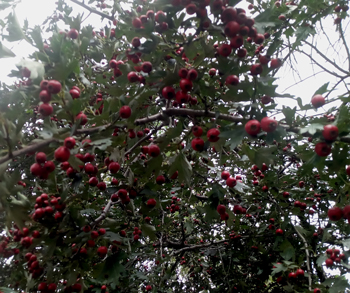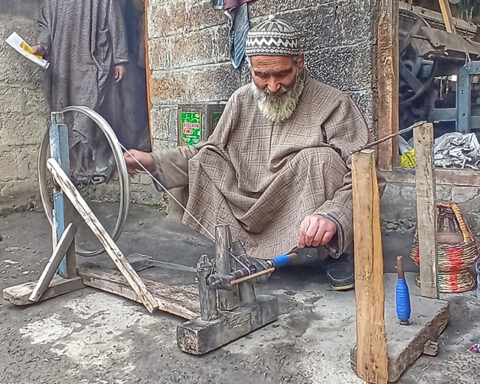Pulwama: Ghulam Mohammad Taedwa, an elderly person from hilly Sangerwani village, recalls his childhood days when he used to wander to nearby forests in search of cherry-like stoned fruits.
“I would collect a bunch of these pea sized rounded dark red fruits and relish them at home with my family members,” Taedwa said, adding that they call them ‘Adding’ in their local language (Gojri).
The fruit is named as ‘Ring’ in Kashmiri. Taedwa informed Awami Moazin that the fruit ripens in late September.
“The ripe ‘Adding’ is sweet in taste,” he said, adding that the fruit is borne by a bushy shrub which was abundantly found in his area years ago.
“Their number declined in low lying areas but it is quite abundant in upper reaches,” he said, adding that the practice of eating the fruit has been discontinued.
“The young generation don’t recognise it as a fruit,” he said.
Shakeel Ahmad Najar, a school teacher from neighbouring Abhama village, recalls his maternal uncle trading in this fruit some years ago.
“My uncle used to purchase the fruit from villagers in good quantity and sell it to a traditional healer from Srinagar,” he said, adding that the fruit finds use in traditional medicine.
However, the trade stopped in the village after Shakeel’s uncle passed away.
Shahid Rasool, a senior scientist in Genetic Resources and Agro-technology, identifies the ‘Ring’ shrub as Crataegus azarolus.
“It has medicinal value and is a plant of interest for researchers,” he said.
It is widely distributed in North Europe, temperate regions of Asia, Africa and North America.
Crataegus azarolus is a deciduous shrub or a tree that can grow up to 10 meters high. In the wild state it is thorny. The fruit of the tree is called as Azerole
The plant also has useful wood and medicinal properties. It is also grown as an ornamental.
Ghulam Mohammad Taedwa informed that they used wood of the tree for making handles of tools including that of axes, shovels, spades and sickles.
Shahid Rasool said that the leaves and unripe fruit have substantial anti-oxidant, anti-inflammatory and antiproliferative activities.
“The raw fruits and decoction of the leaves is used for treatment of diabetes, gastric ulcers and heart condition in traditional system of medicine,” he said, adding that people in Arabian Peninsula use it for sexual weakness.
Conservator Forests South Circle, Irfan Ali Shah, said that it is a naturally growing wild plant and is abundant in Kashmir.
“It is an important associate among broad leaved species and is mostly found in Tral, Kund and whole Anantnag district,” he said, adding that it has medicinal value used for treatment of gastrointestinal ailments and cardiovascular problems.









It is very nice story regarding ring kul
It is very nice story regarding ring kul I used to eat it’s fruits in my childhood.